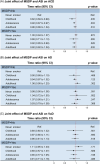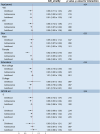The impact of maternal smoking during pregnancy and the age of smoking initiation on incident dementia: A prospective cohort study
- PMID: 38713803
- PMCID: PMC11180862
- DOI: 10.1002/alz.13854
The impact of maternal smoking during pregnancy and the age of smoking initiation on incident dementia: A prospective cohort study
Abstract
Introduction: The impact of early-life tobacco exposure on dementia has remained unknown.
Methods: Using the UK Biobank, the associations of maternal smoking during pregnancy (MSDP) and age of smoking initiation (ASI) with the onset time of all-cause dementia were estimated with accelerated failure time models. The effects of MSDP and ASI on brain structure and their genetic correlation to Alzheimer's disease (AD) were analyzed. A Mendelian randomization (MR) analysis was conducted.
Results: The time ratios for smokers starting in childhood, adolescence, and adulthood (vs never smokers) were 0.87 (0.76 to 0.99), 0.92 (0.88 to 0.96), and 0.95 (0.89 to 1.01). MSDP and smoking in adolescence altered many brain regions, including the hippocampus. In genetic analysis, MSDP was genetically and causally linked to AD, and a younger ASI was genetically correlated to a higher AD risk.
Discussion: Early-life smoking accelerated dementia onset and was genetically correlated to AD. MSDP demonstrated genetic and causal linkage to AD risks.
Highlights: Unlike the commonly used Cox proportional hazards model, this article uses a parametric survival analysis method - the accelerated failure model - to explore the relationship between exposure to onset time. It can be used as an alternative method when the proportional hazards assumption is not met. Genetic analyses including genetic correlation study and MR analysis and brain structure analyses were conducted to support our findings and explore the potential mechanisms. The study reveals the relationship between different smoking initiation periods and the onset time of dementia and shows that earlier smoking exposure has a more significant impact on dementia. It emphasizes the importance of preventing early smoking. In the future, more research focusing on the relationship between early exposure and dementia is called for to provide more detailed prevention measures for dementia that cover all age groups.
Keywords: Alzheimer's disease; dementia; early‐life tobacco exposure; smoking; vascular dementia.
© 2024 The Authors. Alzheimer's & Dementia published by Wiley Periodicals LLC on behalf of Alzheimer's Association.
Conflict of interest statement
The authors declare no conflicts of interest. Author disclosures are available in the Supporting information.
Figures






References
Publication types
MeSH terms
Grants and funding
LinkOut - more resources
Full Text Sources
Medical
Miscellaneous

